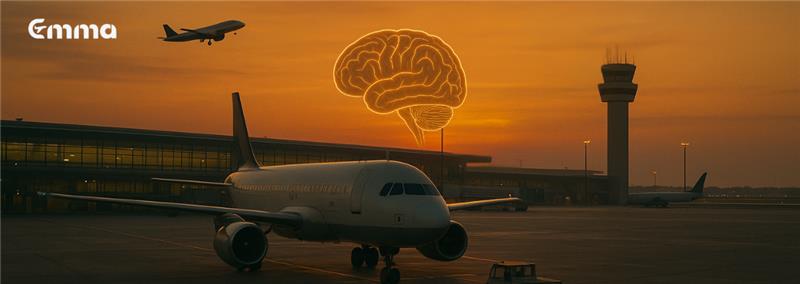Why airports need to rethink their approach to withstand the short-term challenges?

Kris De Bolle joined EMMA Systems last month. Kris has a 25+ year career in airport operations, from which he gained a profound knowledge of the aircraft turnaround process. He is a subject matter expert on Airport CDM, focusing on the key aspects of operational implementation, operational data sharing and stakeholder change management. As an independent consultant, he was also involved in the A-CDM projects of Lyon, Abu Dhabi and Doha Hamad airports. We spent some time with Kris to take a closer look into the future of aviation, the short term or long-term challenges and what approaches airports should adopt to increase their operational efficiency.
Why is operational improvement so critical for airports and what could be the ideal approach for airports?
Kris: “I see that airports can create a lot of benefits by looking at their current infrastructure in a different manner, starting with the landing and departure routes of airplanes. By redesigning these, airports can accommodate more traffic without expanding and without needing much capital investment. Much more can be achieved with exploiting existing infrastructure in a more efficient way, especially there where they cannot always expand because of the sustainability aspects.
Another key element is the stand and gate planning: by improving the predictability of airside operations, airports can accommodate more planes as a result of this, because of improved planning. This improvement can mostly be achieved by having better data quality: the more we know beforehand – based on trustworthy data -, the more capacity we can create.
Collaboration is a third aspect. The closer stakeholders work with each other the more can be achieved in terms of optimization of resources and motivation of the teams. You can become a better airport if the different teams work closely together, better in terms of the KPIs you can achieve, better as an employer of choice as teams feel respected and motivated.”
Based on your past experience, what approaches work best and what approaches tend to fail?
Kris: “It is absolutely crucial to consider every stakeholder as an equal partner in any operational efficiency project. Stakeholders need to be empowered and listened to; they should be considered key for the success of the project. Teamwork makes the dream work. We are dealing with people and what is critical is for people to get recognized in their role and the contribution they can bring. A top-down approach without any form of buy-in never ever worked and will never work. Linked to that, every operational efficiency project with multiple stakeholders is complex and involves a change management approach so communication during the entire trajectory is key. And finally, small incremental steps are better than doing nothing or waiting for a big step in the implementation process. Taking too big steps, too fast often scares off people.”
The aviation industry is facing many challenges, which are for you the biggest ones?
1. Kris: “Did we really ‘Build back better’?. The race to the bottom is continuing even if we had so many good intentions for the post- COVID era. Ever lower rates and increasing pressure on e.g. handling agents is a dangerous downward spiral. We have seen that a lot of people have left the profession for good because of bad working conditions, so the low-cost business model is about to turn into a dead-end street if no action is taken: the well-known ‘pay peanuts get monkeys’ story. So to re-establish the attractiveness of working in our industry we need to rebalance what has been lost already before and certainly after COVID. The fact that airports faced immense staffing issues last year and that this is predicted again for this year, says it all.
2. De-carbonization. Reaching the goals towards 2050 will be very hard, and there are still so many questions to be asked. Are we on a good track to reach our targets? Will the technology enable us to commercialize electrical flying soon enough to reach the targets? And what about sustainable aviation fuels; their footprint still remains fractional. Do we have solutions to produce those fuels in a sustainable way and in sufficient quantities? How fast can airports support the de-carbonization of their own resources by moving to sustainable transportation and the use of green energy for their own purposes? We are currently at only 35 carbon neutral airports of which 28 in Europe alone, so we still have a very long way to go.
3. The passenger experience. Have we learned enough from COVID to increase the travelers ‘appreciation for air travel? We are expecting considerable growth for the industry so we need to make sure passengers feel comfortable and safe when traveling, only then will they increase their travel spending along the way. The experience needs to be worth it esp. if we see that low-cost companies like Ryanair announce the end of very cheap tickets. Both airlines and airports still have a way to go to assure a consistent travel experience, from on time departure to fast check in or a fluent security check, etc… all these elements influence the traveler’s perception and whether he wants to repeat it.
4. Digitalization. AI is playing an ever-prominent role in all aspects of aviation, even in safety critical operations. The challenge will be to make sure that AI is not compromising the safety of our industry. How can we make sure AI solutions get certified in a swift way so we can use it to the fullest in a short timeframe? Ultimately, we should start benefiting soon from all advantages that AI brings, whether on the safety critical operational level or its use in accompanying the passenger on his/her journey from his home to his final destination.
Thank you Kris.



